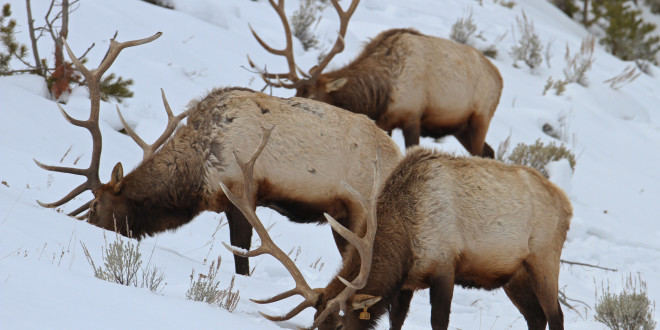This spring, Montana undertook a series of elk captures to better understand how brucellosis moves through the Greater Yellowstone Ecosystem.
Brucellosis is a bacterial disease that can cause cattle to abort. It is found in both Yellowstone elk and bison.
According to Explore Big Sky, officials with Montana Fish, Wildlife & Parks and the Montana Department of Livestock did the captures using a helicopter and net gun:
“There’s just a lot of unknowns with how the disease is circulating,” said Kelly Proffitt, FWP wildlife biologist and one of the lead researchers on the brucellosis study.
Up until about the year 2000, she said, scientists attributed brucellosis transmission to feeding grounds in Wyoming and exchange with bison. “But in the last 10 years, we’ve seen that it’s circulating in free-roaming elk. Current management of bison has really taken them out of the equation.
“The primary mode of transmission between elk and cattle is an abortion event,” she said, adding that an infected cow elk will expel a big load of viable Brucella abortus—the bacteria that causes brucellosis—at the birth site. Domestic livestock could then sniff and lick the area and eat the grass, introducing the bacteria into their system.
The presence of brucellosis in even one herd of cattle can impact the livestock industry state- or nationwide. Explore Big Sky notes that in 2008, when two herds of Montana cattle tested positive, livestock managers lost $12.3 million in revenue due to delayed/canceled shipments.
Yellowstone bison are stringently managed for brucellosis under the Interagency Bison Management Plan, which calls for their numbers to be kept around 3,000 and prevented from expanding their range outside Yellowstone National Park. This winter, over 1,200 bison were hunted and slaughtered. Biologists predict that, come next August, the herd will measure 4,300 animals, down from 4,800 in August 2017.
Despite all the effort put into bison management, there has never been a documented case of bison-to-cattle brucellosis transmission.
A growing body of research, however, shows that elk are far more likely to spread brucellosis to cattle than bison. So far, no one has proposed any sort of management program similar to the one bison live under. Indeed, earlier this year, Montana FWP officials discussed the difficulties facing management of brucellosis in elk.
For one thing, unlike bison, elk are tolerated outside federal/public lands. Two, given how much elk roam, current methods for removing brucellosis from populations (quarantining, vaccination, hunting/slaughter) are infeasible on a large scale. From Explore Big Sky:
“For the most part, most of the seropositive animals—[those who test positive for the presence of brucellosis]—go on to have healthy births [following the first abortion],” Proffitt said. However, it’s possible seropositive animals could continue to shed Brucella even during normal births, and some infected elk have gone on to never calve again.
“Working with wildlife is really difficult. Like everything else, elk are unpredictable … the common pattern is not always followed,” she said, adding that “pregnancy rates aren’t what drives elk populations, so it’s a pretty low consequence for elk, but of really high consequence for livestock.”
Since 2011, the FWP and Department of Livestock have been monitoring “high-risk” elk populations and conducting captures. If a captured elk tests positive for brucellosis, they are fitted with a GPS collar; the following year, pregnant elk are fitted with a transmitter that tracks when an elk gives birth (or aborts).
Around Yellowstone, the FWP and Department of Livestock are monitoring elk around Mill Creek, south of Livingston for brucellosis.
Elk are monitored over the course of five years. After five years, the elk are euthanized so staff can take tissue samples for study in the Montana Veterinary Diagnostic Laboratory. According to Proffitt, hunters or natural causes often take elk before officials can.
 Yellowstone Insider Your Complete Guide to America's First National Park
Yellowstone Insider Your Complete Guide to America's First National Park





